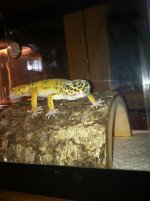blazingecko11
New member
So I was told a numerous of times not to use sand for my geckos because of the risk of impaction and possible dehydration. But I was also told that sand was okay if husbandry was done properly and well maintained. The reason why I'm posting this is because I think sand would look very natural and stunning in a leopard gecko's vivarium, if the gecko was only being a pet and not for breeding. My male leopard gecko who is 5 months old and 7.5 inches long is very healthy and has an extreme appetite for mealworms, crickets, and superworms. He's always been on paper towel. Is there any possible way to have him on sand without the risk of impaction? Ive had quite the experience with these animals just havent really done much with substrate changes. So if there is any way its possible please let me know, if not than I will continue to keep him on paper towel. Thanks for the feed back




